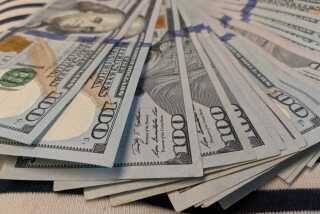Central Banks Fail to Halt Dollar’s Rise : Currency at 2 1/2-Year High, Periling Efforts to Trim Trade Deficit
WASHINGTON — The dollar soared to 2 1/2-year highs on foreign exchange markets Monday, prompting sizable intervention by the major industrial countries and a rare White House statement of “concern” that the increase may impede efforts to trim the trade deficit.
Continuing the surge that began last week, the U.S. currency rose above 140 Japanese yen and pierced the psychologically important barrier of two West German deutschemarks.
Deputy White House spokesman Roman Popadiuk said that the United States “remains fully committed” to the upper and lower limits, never disclosed publicly, that have been set by the major industrial nations for the dollar’s value.
Fluctuation Rumors
Popadiuk, dismissing what he conceded had been some “questioning” of the industrial nations’ support for the dollar’s current level, sought to knock down a report in the New York Times that the Administration was considering allowing the dollar to fluctuate more freely.
He warned that, “if the dollar’s recent rise against other major currencies is sustained for a prolonged period or extended, it could undermine international efforts to reduce global trade imbalances.”
The dollar’s increase makes U.S. exports less competitive and imports more attractive for Americans to buy. Some analysts have said that, if the dollar’s rise is not stopped soon, the trade deficit, which peaked in 1987, could begin to widen again.
Brady Ordered Statement
U.S. officials said later that the White House statement of concern over the dollar’s level was issued at the personal request of Treasury Secretary Nicholas F. Brady.
Officials in other agencies also denied flatly that the United States is about to change its exchange-rate policies.
The statement by the White House climaxed a frenetic day in the markets that saw another round of selling of dollars by the major industrial countries. U.S. officials conferred by phone several times during the day with their counterparts in other countries.
Currency traders said that the dollar’s value is being buoyed by several factors--relatively higher interest rates in the United States than in Japan and West Germany, political uncertainty in West Germany and Japan and the new political turmoil in China.
The dollar closed in New York late Monday at 2.012 deutschemarks, its highest level since December, 1986. It rose to 142 yen, its highest level against that currency since October, 1987.
The foreign exchange markets remained unconvinced that the Group of Seven, as the finance ministers and central bankers of the United States and its six major trading partners are known, would be willing--or even able--to keep the dollar’s value from rising.
Richard E. Witten, vice president for currency trading of Goldman, Sachs & Co., the New York investment house, said that “ . . . these guys (in the Group of Seven) are backing off.”
When the dollar broke the levels of two deutschemarks and 140 yen, Witten said, “those who felt there would be some massing of central banks . . . received a clear message” that the intervention is not whole-hearted. He predicted that Tuesday’s trading sessions will bring “more of the same.”
One factor fueling the perception that the Group of Seven’s central banks were not seriously trying to stem the dollar’s rise was that the West German Bundesbank was conspicuously absent again, the second week in a row that it has refused to help intervene in the markets.
U.S. officials said that they have no real idea why West Germany is not joining in the effort to keep the dollar’s value stable. “We’re just mystified,” one official said. “It must be some sort of domestic political situation.”
But other analysts pointed out that Karl Otto Poehl, president of the Bundesbank, has long doubted that intervention in the markets will work in the long run and that he probably would not be sorry to see the dollar strengthen, because that would help spur sales of West German exports.
Poehl issued a statement in Frankfurt late Monday saying that he believes intervention in the marketplace has only “a limited role.”
Still unresolved is what the United States and its allies will do if the dollar continues to rise sharply over the next few days.
One way for authorities to help stem the increase would be for the Fed to reduce interest rates in the United States while the central banks of West Germany and Japan boost them in their own countries.
However, all three central banks have been reluctant to do that so far. The Fed, for example, wants to make sure that the U.S. economy slows sufficiently to help combat inflation and ease pressure on the trade balance.
THE DOLLAR: ITS UPS AND DOWNS
Japanese West German yen marks to the dollar to the dollar Sept. 27, 1985 240 2.85 Plaza Accord: Agreement by finance ministers and central banks of the United States and its four largest trading partners to try to drive the value of the dollar down. Feb. 22, 1987 154 1.84 Louvre Accord: Agreement by finance ministers and central banks of the United States and its six largest trading partners to keep the dollar stable. Dec. 22, 1987 126 1.63 G-7 statement: Agreement by those seven nations to restabilize the dollar following the October, 1987, stock market crash, but at a lower level for the dollar than had been prescribed by the Louvre Accord. End of 1987 121 1.57 November, 1988 121 1.72 May 22, 1989 142 2.01
SOURCE: Federal Reserve Board
More to Read
Inside the business of entertainment
The Wide Shot brings you news, analysis and insights on everything from streaming wars to production — and what it all means for the future.
You may occasionally receive promotional content from the Los Angeles Times.










